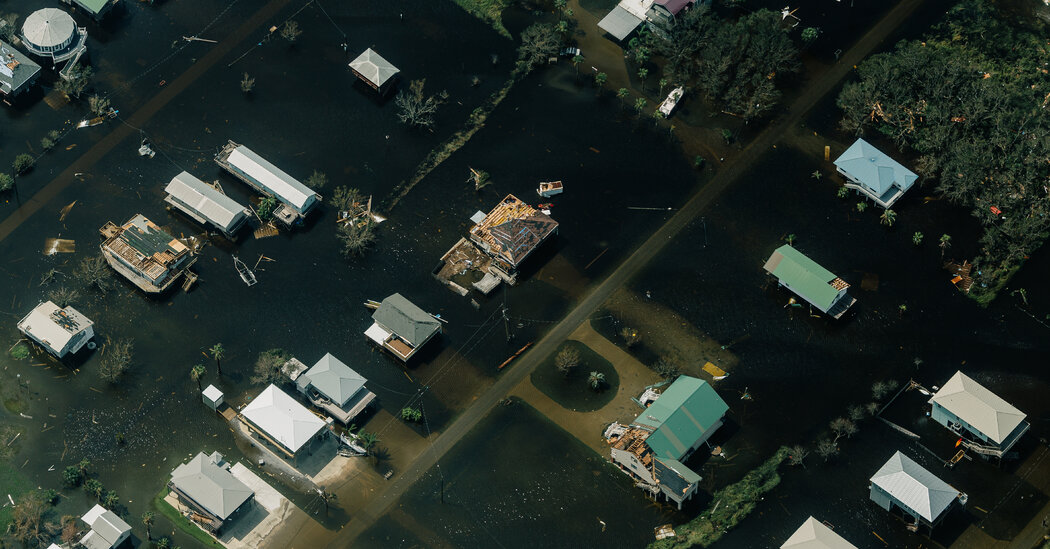
On Grand Isle, a Fragile Spot Off Louisiana, Vast Damage

GRAND ISLE, La. — As Hurricane Ida blew in last Sunday, Scooter Resweber, the local police chief, gathered his 10 officers into his second-story corner office, where he believed they would be most safe.
Behind his small desk two massive panes of hurricane-resistant glass ordinarily give Mr. Resweber a bird’s-eye view of island homes and a postcard view of the Gulf of Mexico, which laps the sand several blocks away. But that day, amid winds of 118 miles an hour, he and his staff saw only destruction.
A two-story building across the street was swiftly reduced to rubble, one of hundreds of structures that were destroyed across Grand Isle. “I watched it just disappear,” he said. “The wind took it. Blew it apart.”
Image

Video

Image
Mr. Resweber, 74, and his officers survived, but the devastation to property and basic services on their fragile island was immense. For more than 24 hours, they lost all communication with the mainland after the radio tower used for walkie-talkies went down. Surveying the impact four days later — no 911 service, no running water, no electrical power — he summed up the situation succinctly. “We ain’t got nothing.”
Hurricane Ida brought hardship to the New Orleans area and many other parts of southeastern Louisiana: prolonged power disruptions and water outages, schools shuttered indefinitely, roads flooded, roofs blown away, homes obliterated. The destruction in Grand Isle was particularly agonizing because the tiny spot was already so endangered.
Part of an eroding chain of barrier islands that fringe the southeast coast of Louisiana, Grand Isle is a narrow strip just eight square miles in all, about a half-mile wide on average. Like all the land in this part of coastal Louisiana, the islands were formed by clay, silt and sand deposited by the Mississippi River — a sort of earthen Jello that has been sinking even as global water levels increase, giving the region the dubious distinction of one of the world’s highest rates of relative sea-level rise.
Image
Image
Image
A longtime sport and commercial fishing hub, Grand Isle is a spot where visitors on tour boats might spy dolphins and pelicans, and where masses of migrating songbirds stop for a rest after crossing the Gulf of Mexico.
Officially, the town is home to 1,200 people, though the local school enrolls only about 150 children because few people live here year-round. The population may swell to 3,000 at the height of the summer, Mr. Resweber estimated, because of the families who gather to catch the sea breeze from “camps” set high on stilts that range from two-room cabins to near-mansions encircled with screen porches. Many have themes or names painted on the front: “Must Be Nice,” “LeBlancs Whispering Oaks,” “Curtis & Norma.”
The last inhabited barrier island in the state, Grand Isle has played a crucial role in hurricane protection for the mainland, providing a “speed bump” to slow approaching storms. In recent years, the federal government has spent $15 million installing breakwater rocks and more than $52 million on a 13-foot-high surge protector known as a “burrito levee” — weather-resistant fabric stuffed with 760,000 cubic yards of sand pumped from the floor of the Gulf. Much of that sand flowed into the island last weekend as Ida split the burrito into two.
Image
Image
Image
Days later, residents were still reeling from the destructive force of the storm.
Ida’s winds had pulled Jim King’s door off its hinges and into the Gulf. “This is the worst I’ve ever seen,” said King, 74, as he looked from his second-story porch onto a sea of missing roofs and rubble. “They’re damn near all gone,” he said.
On Ludwig Street, close to the far edge of the island, Chuck Raum, 56 — one of about four dozen residents who had not evacuated ahead of the storm — pointed to Our Lady of the Isle Catholic Church. There, Ida had pulled large trees from their roots, embedded a two-by-four into the side of the building and shattered the top windows over the church’s vestibule, leaving behind a headless stained-glass Last Supper image.
Mr. Raum’s younger sister, Missy Raum, evacuated inland, taking most of the family pictures from the wall with her. When Ida arrived, he decided that he, too, should leave his three-room family home, built around 1958. “I didn’t know if this place would stay standing,” said Mr. Raum, who packed a backpack with toiletries and one change of clothes and walked down Ludwig Street pulling a beige kayak by a rope until he got to a town building, where he rode out the storm in a stairwell below the police station.
Image
Image
Image
After the winds died down, Mr. Raum rowed home in the kayak, fearing the worst. When he found only a little water and mud on the floor, he fell to his knees. “I’m so grateful that this house survived,” he said. Puzzled for an explanation but ecstatic, he grabbed a marker and a nearby Bible and wrote on the cover, “Chuck! You might read this!”
Mr. Resweber — who moved here 50 years ago as a newlywed — estimates that the storm caused substantial damage to 90 percent of buildings outside of a handful of newer subdivisions, which largely escaped damage, perhaps because of newer FEMA hurricane-resistant building codes, he said.
Much of the damage seemed random. Jay Carter, 38, a former firefighter from Georgia, volunteering with an disaster-aid group called the “Cajun Navy,” said that he had seen a Santa ornament standing tall in the front yard of a completely obliterated house.
Ida flattened some seemingly solid buildings while leaving more rickety-looking homes unscathed. In the Pelican Point subdivision, Mr. Resweber’s house was the only one ruined. His right-hand man, Sgt. Jim Rockenschuh, 78, an island resident since 1949, also lost his house. Both were uninsured; Rockenschuh’s previous homeowner’s insurance premiums had risen to $12,000 a year; the chief’s to $8,000.
Image
Image
Image
Though most of the visible damage on Grand Isle was from wind, Fred Marshall, 59, lost his trailer to “nasty, nasty floodwater.” Still, he said, he didn’t plan to leave.
“It gets into your blood,” he said, as he coasted past on his bicycle, with a quick wave toward his neighbor Leoda Bladsacker, who was sweeping leaves and mud from her second-story porch.
Bladsacker, 66, was born on the island, delivered by a midwife, and so the island is similarly part of her DNA. Though she evacuated ahead of Hurricane Ida, she didn’t feel right until she returned on Thursday. “I needed my feet to touch this earth,” she said.
Source: https://www.nytimes.com/2021/09/05/us/grand-isle-louisiana-ida-damage.html
















